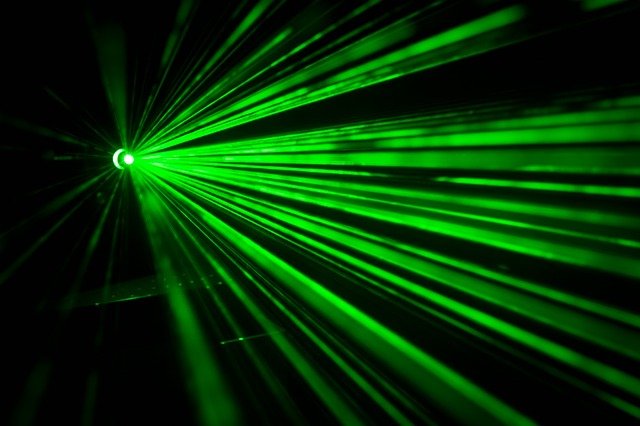A ray in geometry can be defined as any line that has an endpoint called a point of origin and extends forever in a single direction.
As it travels toward infinity, the ray can also pass through many other points.
Rays are usually represented with an arrowhead at one end to indicate their direction of travel and a point where they originate.
Since it is infinite, you can’t determine the distance of a ray.
Rays are common in everyday life with the most common being the rays of sunlight.
They are also extensively used in geometrical diagrams when drawing and denoting angles. When depicting angles, the vertex of the angle is the starting point of the rays.
Although rays and line segments are both parts of a line, they are also different.
- A fixed part of a line is a line segment usually named by two endpoints.
- A ray is also part of a line but with only one endpoint.
- A line has a definite measurable length
- A ray is not measurable as it has a starting point with no other endpoint
To name a ray, you first use a capital letter such as A to denote the endpoint from which the ray originated.
Then use another letter such as B to name any other point that lies on the ray with an arrow (−→) above it.
This becomes AB with an arrow on top of it.
1. Sun Rays

The sun is the earth’s largest source of light rays. This causes the earth to be bathed by up to 4,000 hours of sunlight each year.
Much of this consists of infrared rays (heat) and visible light (which aid us in seeing).
Like a geometrical ray, sun rays begin at a point which is the surface of the sun. Then they extend infinitely in straight lines into space and the solar system.
2. Starlight Rays

Stars are distant celestial bodies that emit light rays in the form of radiation. They are usually found in huge numbers in the sky in groups called galaxies.
Most of the starlight is visible light that travels billions of years to reach earth.
The rays have their starting point in the star and then they are emitted infinitely into space.
3. Flashlight

This is an appliance that is used to provide artificial lighting in darkness or when visibility is poor.
When switched on, light rays are emitted in a strong beam from a lamp or bulb which is the starting point.
The lamp reflects these light rays off an aluminum reflector. The reflector redirects its light rays to produce the beam of light which reaches the surroundings and our eyes.
4. Projector

A projector is a device that is used to project an image on a screen when making a presentation or showing a film.
Examples of these are PowerPoint presentations shown in a business meeting, a product demo at a convention center, or showing a movie from a TV or computer on a large screen.
Rays carrying the images are emitted by the projector. These proceed in straight lines and hit a screen. The rays bounce off the screen and reach our eyes with the images.
5. Moonlight

The moon shines at night to give off light rays to the earth during certain nights of the month.
The light of the moon is reflected light because it has no light of its own.
Like the earth, it receives its light from the sun which acts as the starting point.
6. X-rays

X-rays are a special type of radiation that is produced from electrons that orbit the atom. They are commonly used for medical applications to study body tissues or organs.
X-rays can produce images of the internal body to help doctors examine cavities, blood vessels, and cancerous cells.
X rays machines act as the starting point for the rays which are focused on the body area of interest.
7. Gamma Rays

Gamma rays are very energetic radiation that is released by a radioactive nucleus. They can be compared with x-rays but while electrons in atoms are the starting point for x-rays, the source of gamma rays is the nucleus.
Gamma rays travel infinitely just like geometrical rays but can be stopped and absorbed by objects like bone.
8. Lasers

Laser rays are rays produced from special crystals, glasses, or gases.
When the electrons in these materials are stimulated in a special way, they give off photons (light particles) which we call lasers.
Lasers have many applications such as in laser printers, barcode scanners, laser surgery, or skin treatments.
Lasers differ from ordinary light in many ways. For example, they are highly directional and focused (highly concentrate their beam in one spot). Some lasers like CO2 lasers can cut through steel.
9. Studies Aided by Solar eclipse Rays

The action of light rays during solar eclipses has helped astronomers to study phenomena like solar corona, glowing plasma, and more.
For example, Albert Einstein was able to prove a crucial part of his theory on gravity from an eclipse in 1919.
Light rays coming from distant stars got deflected when passing near the sun due to the sun’s effect on space itself.
The amount of deflection of the light rays offered confirmation of Einstein’s theory.
Conclusion
There you have it; 9 real-life examples of a ray in geometry.
Rays in geometry are a crucial tool used to study and understand many problems.
They provide a visual representation of geometrical paths and are useful for representing and drawing angles.
Related Post: 10 Real Life Examples of a Point in Geometry

